Tom's Hardware Verdict
The Trident Z5 RGB DDR5-6400 C32 combines speed with capacity to help you tackle demanding workloads.
Pros
- +
Great performance on AMD
- +
High capacity
- +
White color
Cons
- -
More costly than the competition
- -
Needs 1.4V
Why you can trust Tom's Hardware
The Trident Z5 RGB DDR5-6400 C32 has the specifications on paper to contend for a spot on the list of the best RAM. When you have a design that works, it makes little sense to alter it. However, companies don't necessarily have to make modifications to the design. Sometimes, offering an already perfectly positioned product in a color that wasn't available previously can help boost sales, too. There are many different types of buyers, and some value aesthetics more than others. Because of the latter, G.Skill's Trident Z5 memory now comes in a white trim, a color that wasn't previously available to the public. Fans of the brand will be happy to know that the Trident Z5 memory can now blend into the ever-popular white-theme builds.



Many of us are accustomed to seeing the Trident Z5 RGB in a metallic silver or matte black theme, so viewing it in a new light is refreshing. The fin-like design with the black brushed aluminum strip remains untouched. The only distinction with this variant is the color of the aluminum heat spreader, which flaunts a nice matte white color. The memory modules are still 42mm (1.65 inches) tall. Double-check the clearance space if you own a big CPU air cooler.
The Trident Z5 RGB gets its fix from the semitransparent light bar that G.Skill placed above the heat spreader. The lighting is vibrant, and the animation is buttery smooth. G.Skill provides the Trident Z Lighting Control software for complete illumination control. Alternatively, you can use the software included with your motherboard as long as it's from one of the vendors on the list, including Asus Aura Sync, Gigabyte RGB Fusion 2.0, MSI Mystic Light Sync, and ASRock Polychrome.


The memory kit contains two 32GB DDR5 modules with a dual-rank design. G.Skill labeled the integrated circuits (ICs) as D5 2GM8GE272325 GB54. However, it was a breeze to figure out the exact model of the ICs. Dumping the SPD shows that these are SK hynix's H5CG48MEBDX014 (M-die) ICs. The vendor is utilizing the 2GB variants, so there are 16 under the heat spreader and eight on each side of the PCB. Meanwhile, the power management ICs (PMICs) are from Richtek, specifically, the 0P=AE RG1 model.
As customary, the memory modules run at DDR5-4800 before XMP 3.0 activation. The timings for DDR5-4800 are 40-40-40-77 for maximum compatibility. A single XMP 3.0 profile resides on the Trident Z5 RGB memory modules. The DDR5-6400 profile will automatically set the timings and DRAM voltage to 32-39-39-102 and 1.4V, respectively, so you don't have to touch any settings inside your motherboard's BIOS. The XMP voltage is a bit high for our liking since some akin memory kits only need 1.35V. See our PC Memory 101 feature and How to Shop for RAM story for more timings and frequency considerations.
Comparison Hardware
| Memory Kit | Part Number | Capacity | Data Rate | Primary Timings | Voltage | Warranty |
|---|---|---|---|---|---|---|
| G.Skill Trident Z5 RGB | F5-7200J3646F24GX2-TZ5RK | 2 x 24GB | DDR5-7200 (XMP) | 36-46-46-115 (2T) | 1.35 | Lifetime |
| Corsair Dominator Titanium First Edition | CMP48GX5M2X7200C36FEW | 2 x 24GB | DDR5-7200 (XMP) | 36-46-46-116 (2T) | 1.40 | Lifetime |
| Corsair Dominator Titanium First Edition | CMP64GX5M2X6600C32FEW | 2 x 32GB | DDR5-6600 (XMP) | 32-39-39-76 (2T) | 1.40 | Lifetime |
| G.Skill Trident Z5 RGB | F5-6400J3239G32GX2-TZ5RW | 2 x 32GB | DDR5-6400 (XMP) | 32-39-39-102 (2T) | 1.40 | Lifetime |


The Intel system runs the Core i9-13900K on the MSI MEG Z690 Unify-X with the 7D28vAA firmware. In contrast, the AMD system pairs the Ryzen 7 7700X with the MSI MPG X670E Carbon WiFi changed to the 7D70v18 firmware. The Corsair CUE H100i Elite LCD liquid cooler keeps our Raptor Lake and Zen 4 processor operating temperatures under check.
The MSI GeForce RTX 4080 16GB Gaming X Trio tackles the more graphics-intensive workloads, ensuring that there isn't a graphics bottleneck in our gaming RAM benchmarks. The Windows 11 installation, benchmarking software, and games reside on Crucial's MX500 SSDs. Meanwhile, the Corsair RM1000x Shift ATX 3.0 power supply provides our systems with clean and abundant power, directly feeding the GeForce RTX 4080 with a native 16-pin (12VHPWR) power cable. Lastly, the Streacom BC1 open-air test bench is vital to organizing our hardware.
Get Tom's Hardware's best news and in-depth reviews, straight to your inbox.
| Component | Intel System | AMD System |
|---|---|---|
| Processor | Intel Core i9-13900K | AMD Ryzen 7 7700X |
| Motherboard | MSI MEG Z690 Unify-X | MSI MPG X670E Carbon WiFi |
| Graphics Card | MSI GeForce RTX 4080 16GB Gaming X Trio | MSI GeForce RTX 4080 16GB Gaming X Trio |
| Storage | Crucial MX500 500GB, 2TB | Crucial MX500 500GB, 2TB |
| Cooling | Corsair iCUE H100i Elite LCD | Corsair iCUE H100i Elite LCD |
| Power Supply | Corsair RM1000x Shift | Corsair RM1000x Shift |
| Case | Streacom BC1 | Streacom BC1 |
Intel Performance
















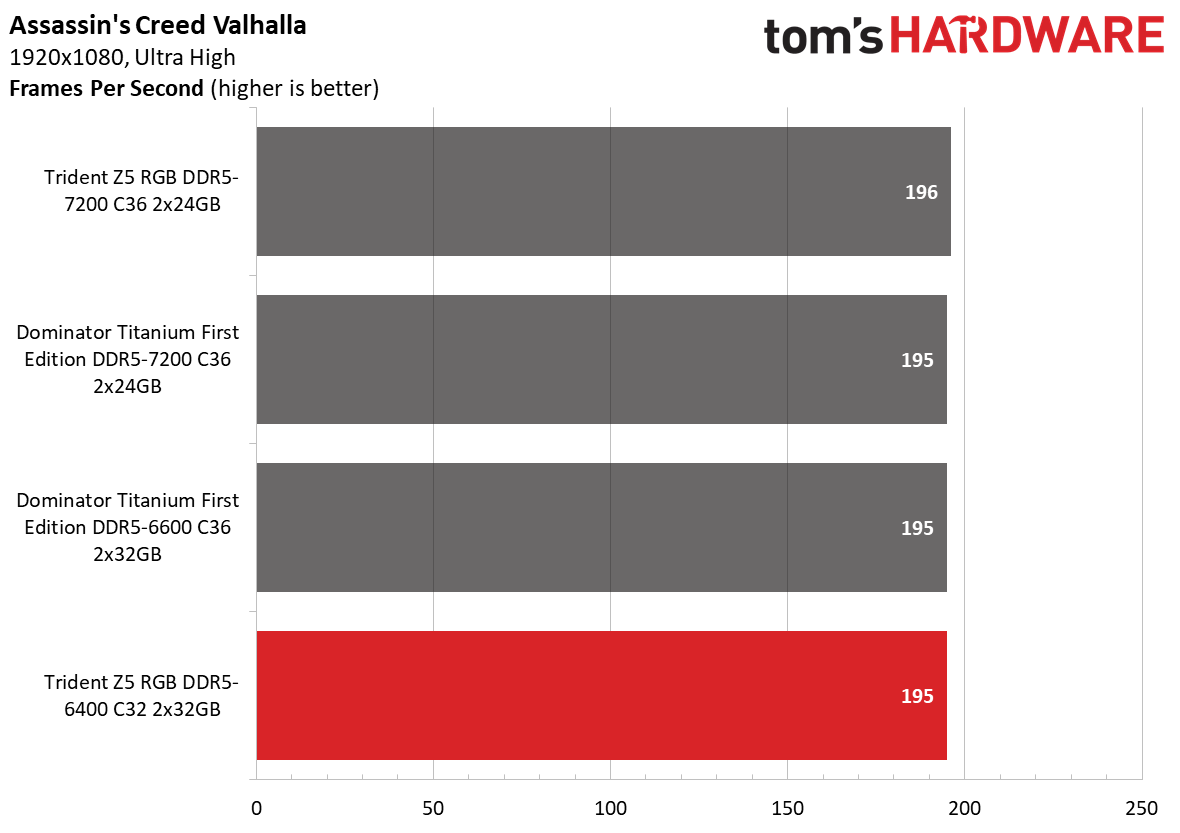



The Trident Z5 RGB slightly trailed behind the Dominator Titanium First Edition DDR5-6600 C36 due to the latter's higher frequency. It was logical that it couldn't outperform the other DDR5-7200 memory kits. However, the Trident Z5 RGB excelled in the Adobe Premiere benchmark, which favors memory kits with higher capacities. The Trident Z5 RGB put up to 3.4% higher scores than the DDR5-7200 rivals.
AMD Performance


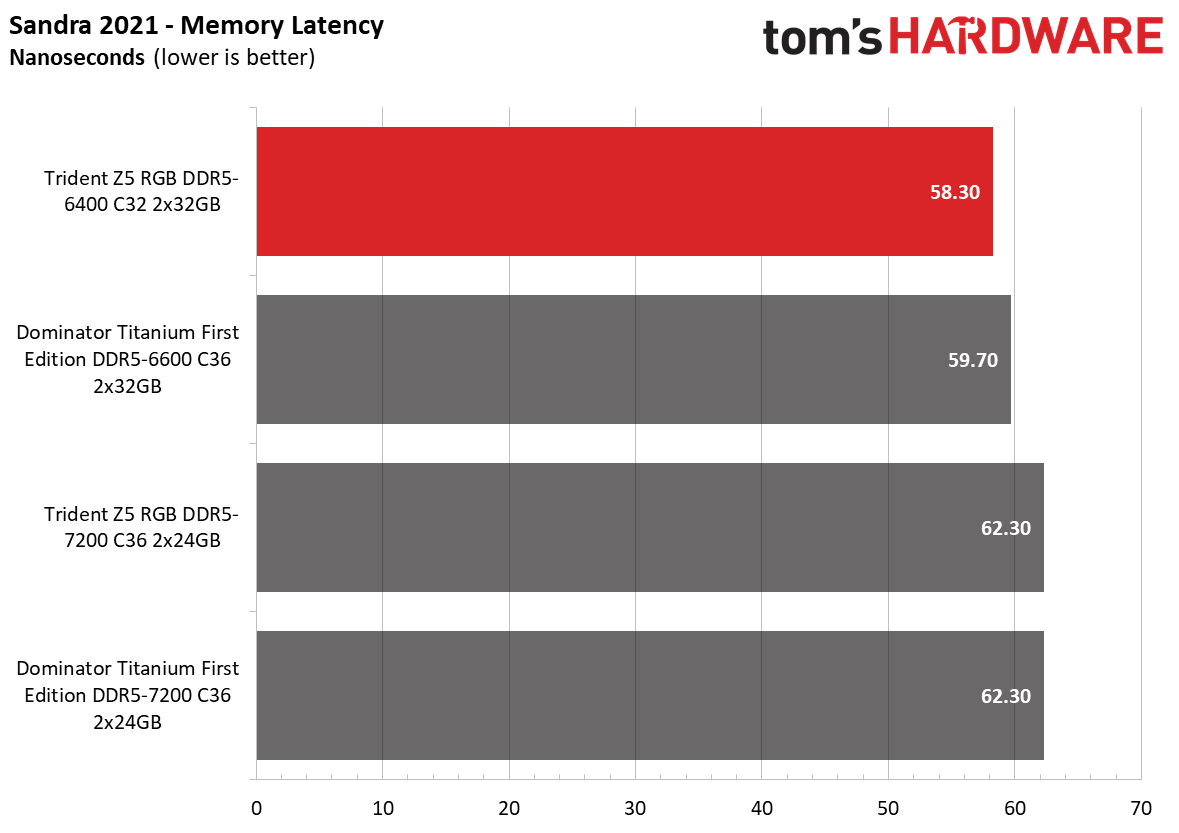


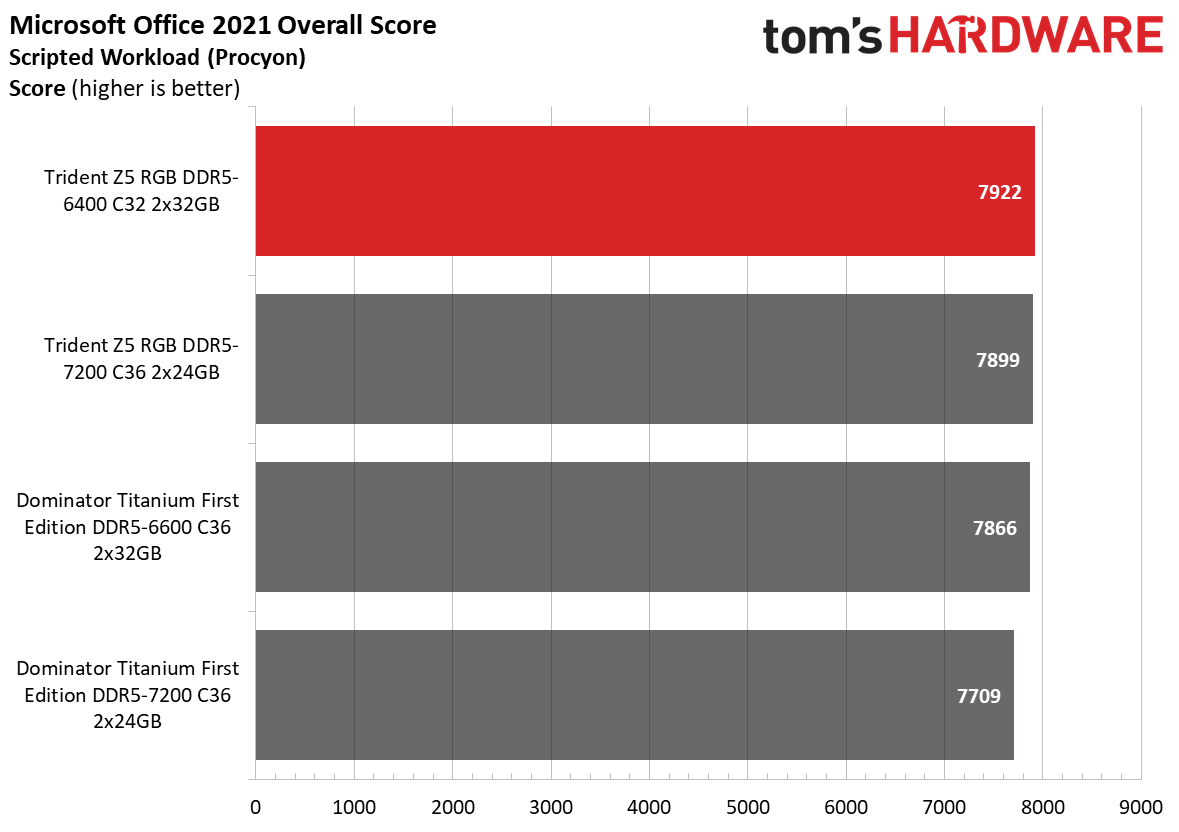






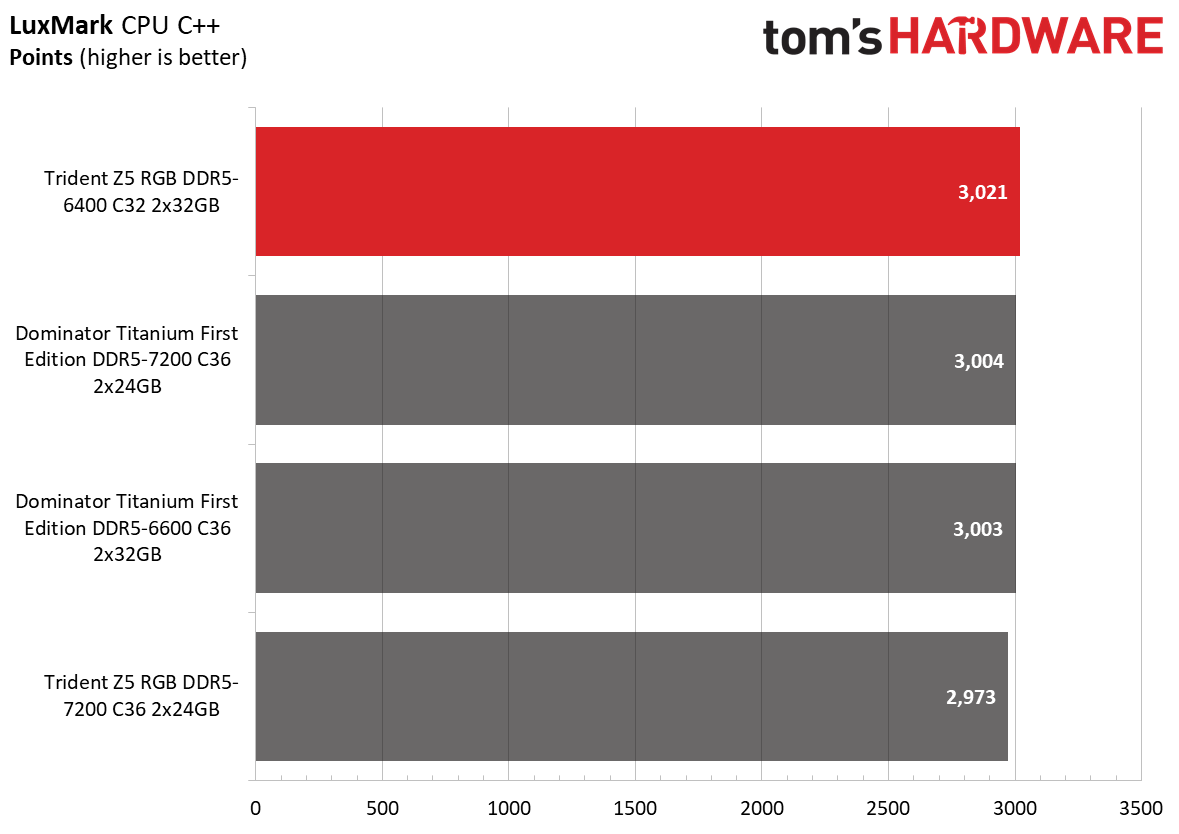

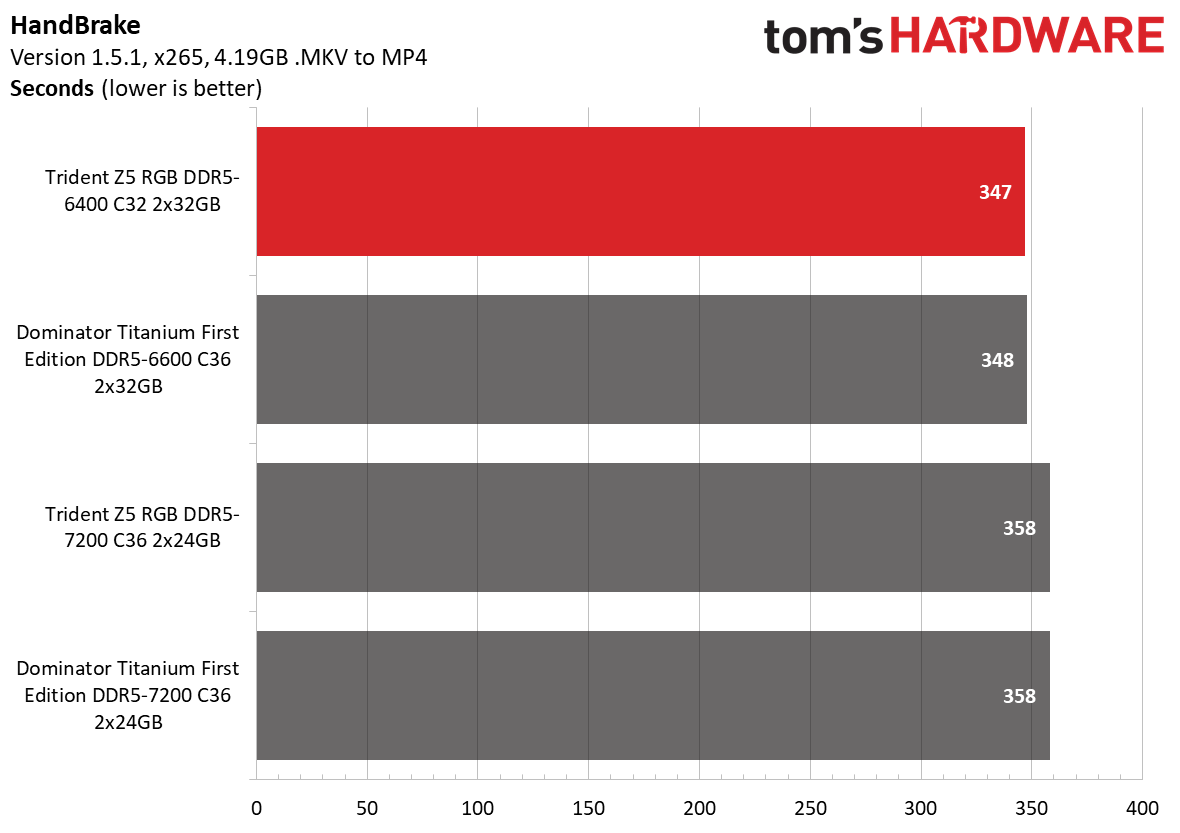



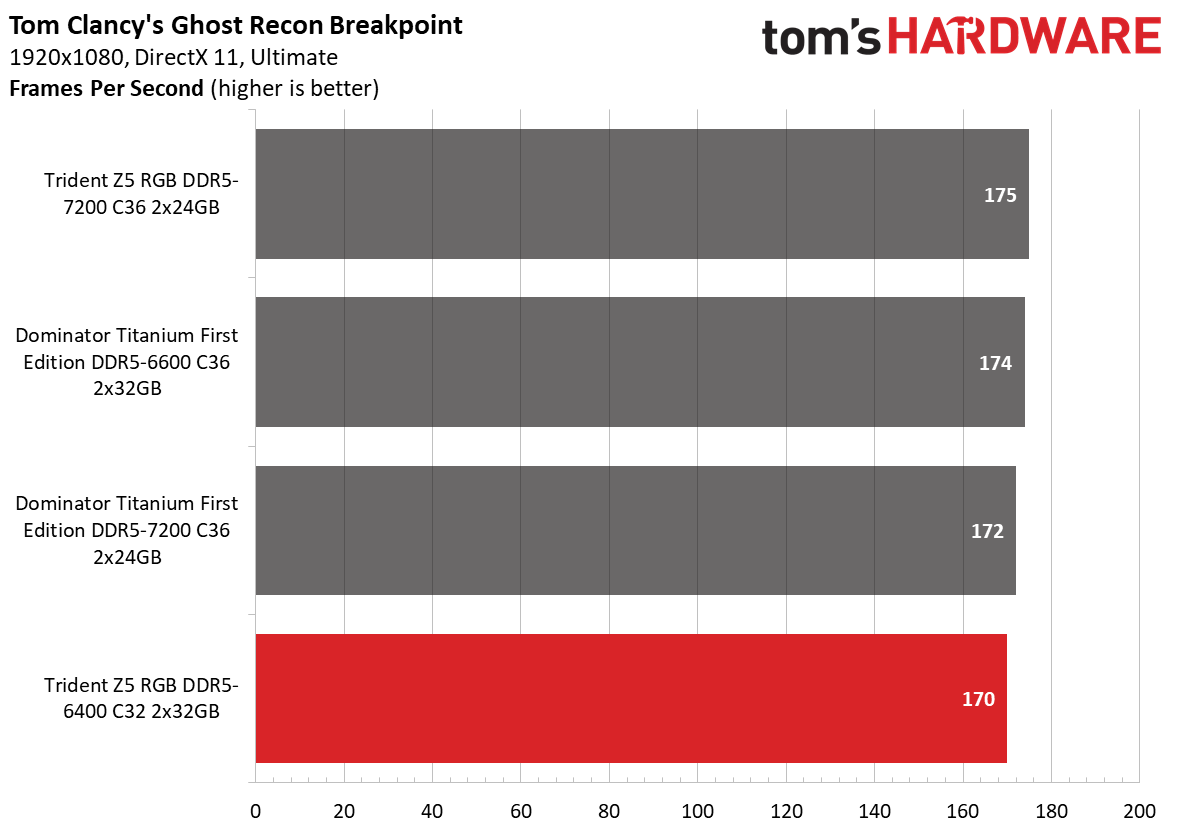

The Trident Z5 RGB memory kit was on the borderline of what AMD's Zen 4 processors can handle regarding running the UCLK and MCLK in a 1:1 ratio. Logically, it gave G.Skill's memory kit an edge over the competition. The other memory kits are clocked significantly higher, forcing the processor to run in a 2:1 ratio where the memory took a slight performance hit.
Overclocking and Latency Tuning



The Trident Z5 RGB exhibited similar overclocking margins as the faster Dominator Titanium First Edition DDR5-6600 C32. The former has M-die ICs, while the latter possessed the previous A-die ICs, so it didn't surprise us that the Trident Z5 RGB caught up to the Dominator in overclocking. DDR5-6800 on the Trident Z5 RGB was possible with identical XMP timings (32-39-39-102) and a slight DRAM voltage bump from 1.4V to 1.45V.
Lowest Stable Timings
| Memory Kit | DDR5-6400 (1.45V) | DDR5-6600 (1.45V) | DDR5-6800 (1.45V) | DDR5-7200 (1.45V) | DDR5-7600 (1.45V) | DDR5-7800 (1.45V) |
|---|---|---|---|---|---|---|
| Corsair Dominator Titanium First Edition DDR5-7200 C36 | N/A | N/A | N/A | 34-42-42-82 | N/A | 36-46-46-116 |
| G.Skill Trident Z5 RGB DDR5-7200 C36 | N/A | N/A | N/A | 34-42-42-84 | 36-46-46-115 | N/A |
| G.Skill Trident Z5 RGB DDR5-6400 C32 | 32-37-37-77 | N/A | 32-39-39-102 | N/A | N/A | N/A |
| Corsair Dominator Titanium First Edition DDR5-6600 C32 | N/A | 32-37-37-76 | 34-39-39-76 | N/A | N/A | N/A |
Depending on the IC quality, SK hynix ICs typically have a limit in tight timings. We got the Trident Z5 RGB down to 32-37-37-77 at 1.45V, which is nearly the same result we obtained with the Dominator memory kit (32-37-37-76).
Bottom Line
G.Skill products hardly disappoint. Whether buying it for the new color theme or the performance, the Trident Z5 RGB DDR5-6400 C32 won't disappoint you. It may not be the fastest memory kit, but it offers just the right amount of performance. Overclocking is always on the table if the out-of-the-box performance doesn't satisfy you. The emergence of 48GB memory modules means bigger capacities exist. Nonetheless, 64GB is still plenty for prosumers and professional workloads, so the Trident Z5 RGB DDR5-6400 C32 is well situated in the market.
Pricing on the Trident Z5 RGB DDR5-6400 C32 is a bit higher than the competition. The memory kit retails for $214.99, while rival memory kits with matching or even better timings start at $185. However, the Trident brand has grown to become synonymous with quality, performance, and reliability, so some of the higher-end products sometimes carry a small premium.
- MORE: Best RAM
- MORE: DDR DRAM FAQs And Troubleshooting Guide
- MORE: All Memory Content

Zhiye Liu is a news editor, memory reviewer, and SSD tester at Tom’s Hardware. Although he loves everything that’s hardware, he has a soft spot for CPUs, GPUs, and RAM.
